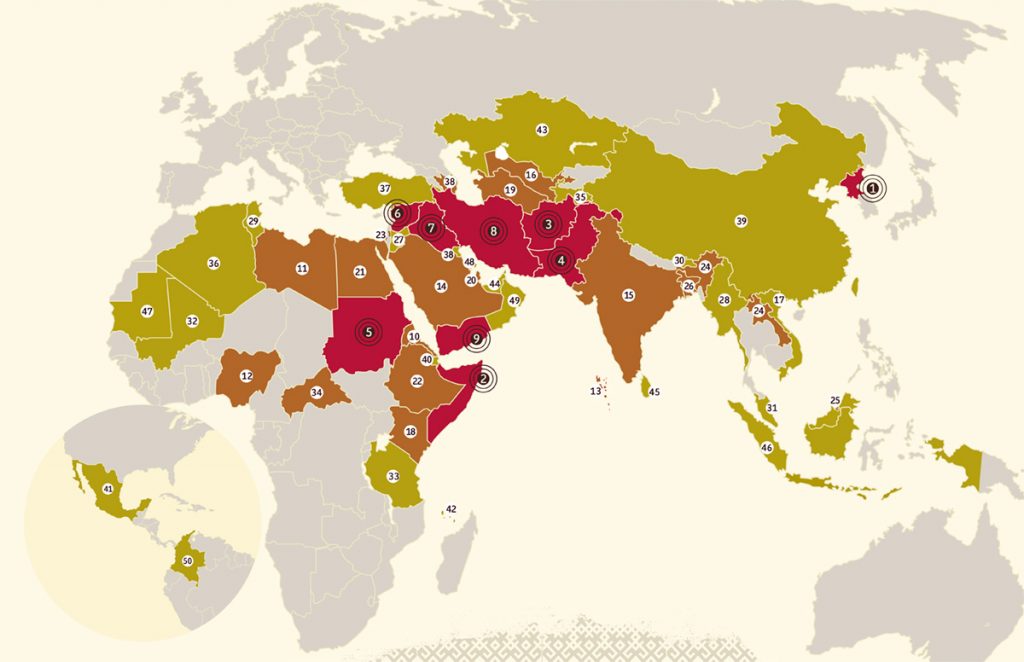Open Doors has just released the 2017 World Watch list,
an annual report on the global persecution of Christians, published in the form of a list ranking the top 50 countries where Christians are persecuted for their faith. Released at the beginning of each year, the list uses data from Open Doors field workers and external experts on Christian persecution to quantify and analyze persecution worldwide.
…from Open Doors’ website – the list itself can be found here.
From Religion News Service:
Almost one in 12 Christians in the world lives in a place where practicing their religion is forbidden or even punishable under the law, according to the 26th annual “World Watch List” report. Compiled by Open Doors USA, the list ranks the top 50 countries where Christians are most severely persecuted. North Korea tops the list for the 16th year in a row, but the report concludes that Islamic extremism “remains the global, dominant driver of persecution.”
“Christians throughout the world continue to risk imprisonment, loss of home and assets, torture, beheadings, rape, and even death as a result of their faith,” the report states.
The report states that approximately 215 million Christians now experience high or extreme levels of persecution. This number may be overinflated given Open Door’s vague and broad definition of persecution, which includes “any hostility experienced as a result of identification with Christ.” Even still, the situation faced by millions of Jesus-followers around the world is dire.
An RNS interview with David Curry, CEO of Open Doors, looks in particular at the impact on women:
DC: With Islamic extremists, and also Hindu extremists in India and Nepal, women are particularly vulnerable pawns in their religious wars. Raping, sexual harassment, and forced marriages are not uncommon tactics for extremists to use. Some sex traffickers, for instance, have reported to Open Doors that they are given financial incentives to abduct women who are related to Christian pastors. We have also learned of specific plots to lure Christian women to marry under false pretenses for the purpose of drawing them away from the Christian faith.
Islamic extremists also have an agenda to impose Muslim dominance and Sharia law on culture. This creates conditions that are highly restrictive for women and intolerant of Christians. Christian women, then, live at the crossroads of the two. They face a sort of double discrimination as a result of both their faith and their gender. They are mistreated because they are women and persecuted because they are Christians.
With this year’s World Watch List, Open Doors is calling the world to protect the dignity of all women, but especially the Christian women living in these hostile regions. Christians in these communities are overwhelmed, and—in areas where extremists wield power—police forces and governments can’t be relied upon to protect individual Christian women in these communities.
The report lists the following as the 12 most dangerous countries for Christians:
1. North Korea
2. Afghanistan
3. Somalia
4. Sudan
5. Pakistan
6. Eritrea
7. Libya
8. Iraq
9. Yemen
10. Iran
11. India
12. Saudi Arabia
It may or may not have to do with the U.S., where Christians are an unpersecuted majority:
It’s possible that recent American foreign policy has contributed to a worsening of the the situation faced by Christians in these places.
In the wake of American-waged wars, Iraq (#8) and Afghanistan (#2) have experienced increased religious oppression. Libya (#7) has become a hotbed for Islamist terrorism after American military demolished its government. Four countries among the top 12 are included in President Trump’s travel ban, and relations with Pakistan (#5) are strained due to his administration’s attempt to block millions of dollars in aid. The president recently brokered trade and weapons deals with Saudi Arabia (#12).
Regardless, Open Doors reports that Christian oppression globally is intensifying at an alarming rate. Of the 50 countries listed, more than 30 saw a notable increase in persecution during the reporting period.

